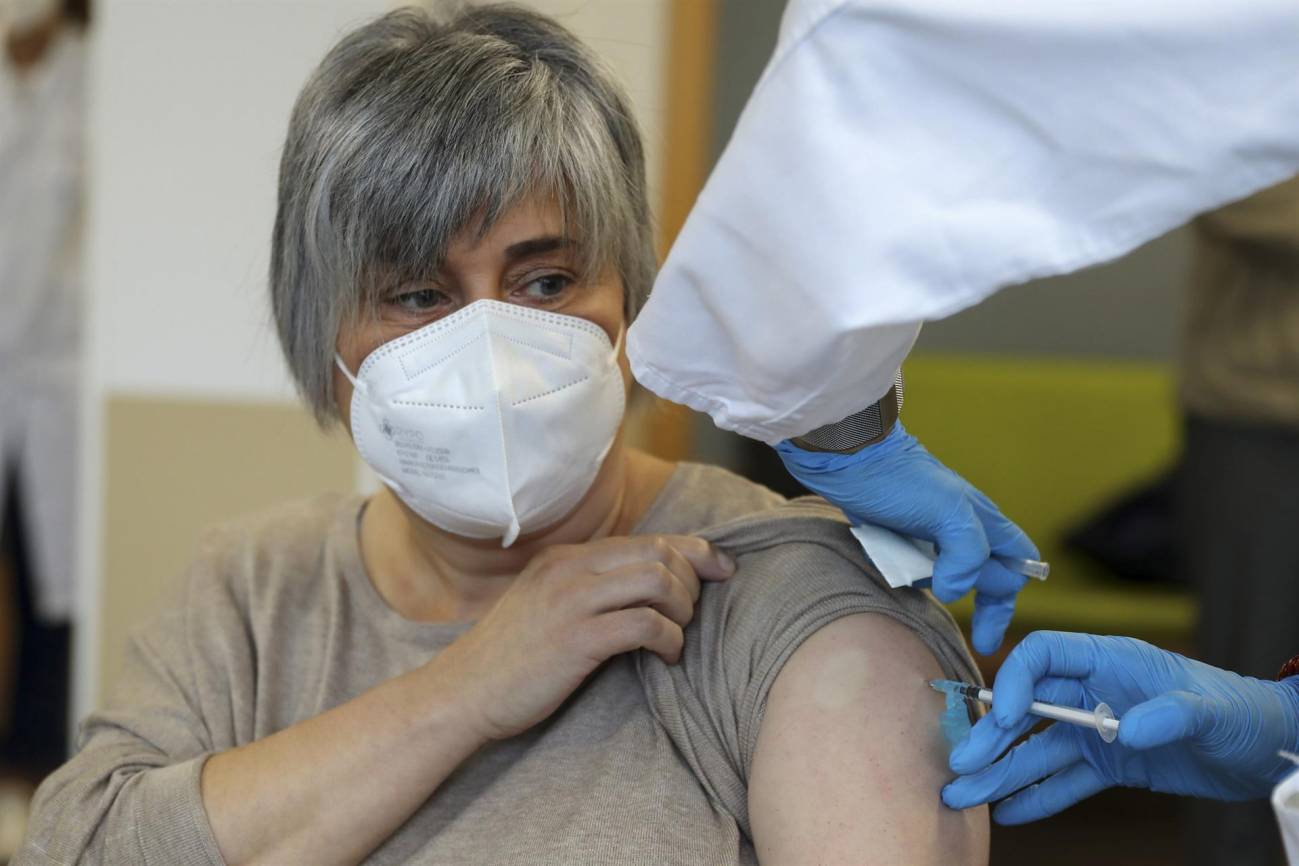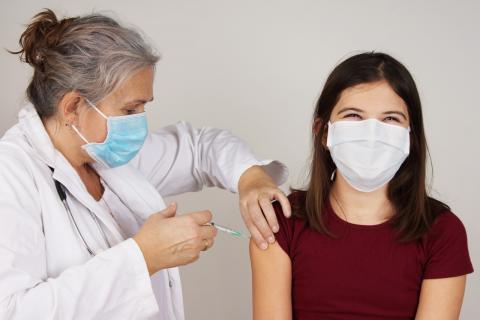Reactions to Phase 1 trial of a new prototype universal flu vaccine
A study published in the journal Science Translational Medicine shows the results of a phase 1 trial of a new broad-spectrum influenza vaccine. Prepared in the form of nanoparticles containing the H1 hemagglutinin stem-a region that is often conserved in different subtypes of the virus-the vaccine was generally well tolerated by participants, who showed only mild side effects such as tenderness and headaches. The prototype generated an antibody response to group 1 influenza viruses in all age groups.

Inmaculada Casas - vacuna universal gripe EN
Inmaculada Casas
Head of the Respiratory Virus and Influenza Research Group of the Carlos III Health Institute
This study shows the results of a first-in-human Phase 1 clinical trial that has demonstrated that in healthy adults the new H1ssF vaccine is safe, well tolerated and immunogenic even without adjuvant. The vaccine generates broad-spectrum antibodies targeting the stem part of the viral hemagglutinin (HA), which serves the influenza A HA subtypes belonging to group 1 and is very poorly reactogenic.
The H1ssF vaccine consists of the elimination of the HA head where the antigenic sites are located and is therefore immunodominant.
The study is very complete and of very good quality.
H1ssF vaccine increased group 1 influenza binding antibodies in all age groups. In general, currently licensed influenza vaccines are less effective in older adults, but the authors show that the H1ssF vaccine does not differ in antibody responses as a function of age, so its use would be advantageous in those over 60 years of age.
Although an H1 antigen from the pre-2009 stem was used, the authors find adequate responses to stems diverging more than 20% in sequence from H1, including H5 and H2. The application for avian influenza prevention could be immediate.
In terms of limitations, the heterogeneity of pre-existing influenza immunity is an important confounding factor for the investigation of the immune response induced by new vaccines to be studied. In addition, according to the trial authors, the covid-19 pandemic slowed the progress of the trial and caused 23% of the participants to be lost.
By measuring antibody production against the stem, it can be proven to be immunogenic, i.e., antibodies are produced against the selected antigen. However, the vaccine effectiveness would be measured over the seasons with street viruses being replaced. With this assay, in my opinion, it would not be possible to speak of "global" vaccine effectiveness, because this would measure the protection of a vaccinated population against the viruses of the season, testing different seasons. It is noteworthy that the antibodies have been produced specifically against the antigen that they have constructed and that theoretically serves for several influenza subtypes (group 1).
Future studies will need to determine the optimal stem antigens for a safe, broad-spectrum influenza vaccine.
Estanislao Nistal - vacuna universal gripe EN
Estanislao Nistal
Professor of Microbiology at the Faculty of Pharmacy
The study is interesting. It is a continuation of a line of work that these researchers have been developing since a paper they published in 2015. It represents a further step in the strategy to achieve a universal vaccine against influenza.
In this case, the researchers use as a vaccine an artificial protein containing a fragment of the ferritin protein from the bacterium Helicobacter pylori attached to the hemagglutinin stem of the influenza virus. The ferritin fragment organizes itself by assembling to form nanoparticles, which serve as a platform for the hemagglutinin stalk to be stable.
In previous work, the researchers have shown that this artificial protein can induce an effective response to infection in animals. In this work they go a step further and prove that this vaccine construct is able to induce the production of antibodies against different hemagglutinins of group 1 of influenza virus type A, such as hemagglutinins H1, H2 or H5, three very relevant hemagglutinins. H1 is a hemagglutinin present in current viruses. H2 is a hemagglutinin that gave rise to the "Asian flu" pandemic in 1957 and is not present in viruses currently circulating in humans, but has the potential to do so. Finally, hemagglutinin H5 is the hemagglutinin present in avian influenza, with latent pandemic potential. The data presented indicate that, potentially, the vaccine presented has the potential to protect against infection by inducing neutralizing antibodies in vaccinated individuals.
The researchers also present data on the safety and symptoms associated with vaccination, which appear as minor symptoms but with the presence of reactogenicity of different types in about 20% of vaccinated individuals.
The strategy employed uses proteins, it is neither a messenger RNA vaccine, nor an inactivated or attenuated virus vaccine, nor does it use viral vectors for vaccination. It is a vaccine that, in principle, has a very well-defined formulation and with a relative ease of quality control and reproducibility in the manufacture of batches, which may present problems with other types of vaccines. This vaccine tries to stimulate the production of antibodies against the most conserved area of the hemagglutinins of different influenza A viruses that belong to a common group, such as hemagglutinins H1, H2 and H5 or another that, although not tested, can also produce infections in humans, such as H9. Potentially, this vaccine can protect against different influenza viruses that have these hemagglutinins.
The presence of neutralizing antibodies to influenza viruses has traditionally been considered an effective marker of immunization to protect against the virus. However, stimulation of cellular immunity is also a component that is very effective in protecting against the disease. No cell-mediated immunity data are shown in this study. The type of antibodies produced and their production over a year suggests that at least CD4 T cells are stimulated, which assist B cells in their task of antibody production.
Another limitation that the researchers of this study will probably address in the future is to what extent immunization with this vaccine can protect a patient from becoming infected, how long that protection would last, and how many times a patient should be vaccinated to have good protection, as is the case with older people or other particularly susceptible groups, where the virus represents a higher risk.
Lejarazu - Gripe (EN)
Raúl Ortiz de Lejarazu y Leonardo
Professor of Microbiology, scientific advisor and director emeritus of the National Influenza Centre in Valladolid
It is a study of very high quality, well conceived for the proposed objectives and impeccably carried out. The signatories are people of proven experience in this field, with numerous publications. I know some of these scientists personally.
It is a continuation of previous work. It is known that current influenza vaccines only protect against that year's influenza strains, with antibody evanescence after six months. HA (haemagglutinin) is the key component of influenza vaccines (like glycoprotein S in SARS-CoV-2 vaccines) and has two regions: one that varies a lot (the head) and one that varies little (more conserved), which is the stem. There are 16 different types of HA (plus two in bats that are not relevant) that are associated with two types of stems, 1 and 2. In this work they have tested the protein of stem 1, which serves for cross-protection against H1, H2 and H5 (although within the phylogenetic group 1 of the stem there are also 9, 11, 12, 13 and 16).
It has been manufactured on a platform with nanoparticles that allow better vehicleisation of the antigen and the results are very encouraging.
There are always limitations. Theoretically there are more types that have not been tested, but they are very rare and only present in wild birds. The duration of the antibodies seems good, over a year, so it meets the 2017 WHO targets.
In influenza, antibody measurements have been an accepted correlate of protection for over 50 years. It's not perfect, but it's pretty close. On that side of the article, there is nothing to doubt.
Widge et al.
- Research article
- Peer reviewed
- Clinical trial
- People



